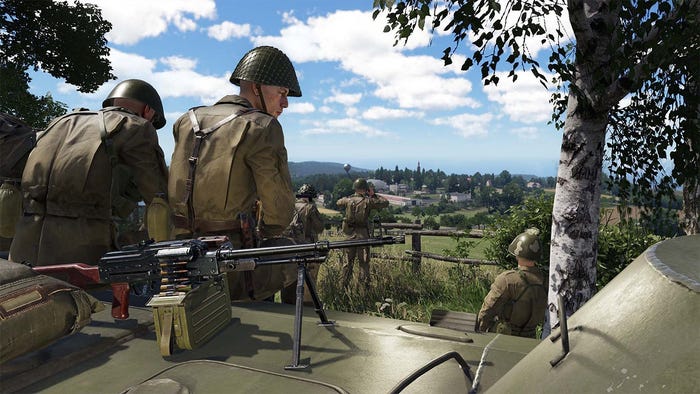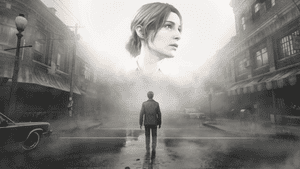Mapping the lessons of psychology to game design
In this reprint from the May 2012 issue of Game Developer magazine, Jason Vandenberghe draws connections between the 'Big 5' psychological motivations and their corresponding goals in game design.

Can you map a player's desires down to a science? Here, in this reprint from the May 2012 issue of Game Developer magazine, Jason Vandenberghe draws connections between five major motivational factors and their corresponding goals in game design. Over the last twenty months, I've been trying to draw correlations between the Big 5 motivational factors and game design elements that cater to those factors by interviewing any game player willing to take a test about their play behavior. In essence, I wanted to translate the work of motivation psychologists into game design -- and I managed to draw a few correlations sooner than I had expected.
Open Source Psychology
Before we get our hands dirty, I want to mention a few things about why the Big 5 system is different from other systems. For starters, the Big 5 system doesn't come from a single person -- it is an international collaboration between dozens (hundreds?) of researchers. Instead of keeping the data driving the discoveries copyrighted and secret, or preventing correlative studies with other systems, the data behind the Big 5 system was subjected to every imaginable cross-analysis-- which is ongoing, and will be into the foreseeable future. And while the contributors could have owned the discoveries and charged for their use, they decided to release the entire thing into the public domain. In other words, the Big 5 system is the Linux of motivation psychology.
Bells and Curves
When you take the Big 5 test (the best free one I've found), you get a report that shows where you fall in five personality "domains," as well as in the individual character "facets" that make up those domains. Each of these domains is defined as having a standard distribution (read: bell-shaped curve) when applied across humanity. A low score or a high score means that for that particular facet your motivation is a rarity, and a score in the middle means that for that facet your motivation is similar to a majority of the population. This means we have a statistical baseline for any analysis we'd like to do, which is a Very Good Thing--as we apply this system to game development, we can swap out vague assertions like "most gamers want X" for factual statements like "half the human population has a preference for X, and the other half for Y." Even better, we can begin to accurately measure different player populations. Have you ever wondered whether the "core gaming" population is statistically different in it's preferences than the rest of the world? Well, now we're one detailed study of players away from having an answer.
Two Sides to Every Story
Each domain, or "factor," is a two-sided spectrum with a positive motivation on each end. This may seem obvious at first: Some people are open to new experiences, and others less so, for example. Well, compare that two-sided structure to the commonly-held-in-the-game-biz archetype of the Achievement Player. What is the positive opposite of an Achievement Player? The developers I have worked with tend to talk about Achievers like this: If your game satisfies Achievers, you'll probably get those players to play your game. If your game doesn't satisfy Achievers, you'll fail to attract those players, and by implication you make less money. I have started calling this way of looking at players as the "thermometer model" of motivation--you stick a thermometer in the game and you measure its "Achievement-ness." High is good, low is bad. But from what I have learned so far, that view is completely wrong. The opposite of an "Achievement player" is a "contentment player:" someone who is perfectly happy to ignore your target goals, difficulty challenges, and medals, and just hang out. Someone who is motivated to be content with their current state and who will buy games that let them act on that motivation. Remember the bell-shaped curve discussion above? We're talking about 50 percent of humanity being on the "contentment" side of the curve. That's an awful lot of players who are not being discussed in most design meetings, thanks to a simple misunderstanding of how player archetypes work.
Swimming in the O.C.E.A.N.
Let's get down to business. The Big 5 are:
Openness to Experience Conscientiousness Extraversion Agreeableness Neuroticism
-- "O.C.E.A.N." Openness to Experience distinguishes creative, intellectual folk from down-to-earth, pragmatic ones. A high scorer would be Alice In Wonderland, who is happy to drink whatever she comes across and follow rabbits into the unknown. Alice finds Wonderland a delight. A low scorer would be Samwise Gamgee, who just wants to go home, have a predictable life, and not bother about with wizards quite so much. Conscientiousness deals with our ability to control our impulses and order our world the way we want it. A high scorer would be Hermione Granger, who is the best in her class at almost everything, and who is the one you go to when you need to get something difficult accomplished. A low scorer would be Jeff "The Dude" Lebowski, whose primary ambition in life is to bowl, and who can turn nearly any simple outing into a near-complete disaster. Extraversion deals with the desire for external stimulation, both social and otherwise. A high scorer would be Austin Powers, who is always ready to party, much prefers the company of others to solitude, and is the leader of the pack. A low scorer would be Edward Scissorhands, who is happy to do whatever you want, please, just leave him alone, in the dark. Agreeableness deals with cooperation and social harmony. A high scorer would be Charles Xavier, who puts the needs of others ahead of his own, believes in the good in people, and who understands how you're feeling better than you do. A low scorer would be Snake Plissken, who, if you want him to care about another human being (like the president), you have to inject explosives into his neck that will detonate if that person dies. Neuroticism reflects how strongly one experiences negative (and only negative) emotions. A high scorer in Neuroticism would be Woody Allen (the character, not the man), for whom the world is a panoply of fears, anxieties, angers, and frustrations. A low scorer would be Obi-Wan Kenobi, for whom fear, anger, and jealousy lead to the dark side of the Force, and who met his death with a polite salute.
Facets Within Factors
Your score in each domain in the Big 5 is actually something like a weighted average of your score in six "facets" that describe specific preferences within that domain. For example, Openness to Experience is composed of Imagination, Artistic Interest, Emotionality, Adventurousness, Intellect, and Liberalism; Conscientiousness includes Self-Efficacy, Organization, Dutifulness, Achievement-Seeking, Self-Control, and Cautiousness; and so on. I won't list them all exhaustively--take the test yourself, read the Wikipedia page, or just Google "Big 5 facets" to see them all. As you will see, many of these facets describe polarities that game designers already use. These facets are where the proverbial rubber meets the road for game design.
The Five Domains of Play
With the psychology described, we can go looking for game elements that will satisfy these motivations. In order to do this, I have been interviewing gamer players after they take the Big 5 test, with the idea that people with a similar score in specific facets should theoretically prefer similar games or game elements (such as PvP, achievements, grouping, and so on). My database isn't complete, but I have uncovered strong evidence for many direct associations between the Big 5 facets and game elements. The notable exception is Neuroticism, which refuses to produce predictable correlations so far. That said, based on the data so far, translating the Big 5 into game elements gives us these five domains of play: Novelty, Challenge, Stimulation, Harmony, and Threat. Novelty (which maps to Openness to Experience) is the presence or lack of new, interesting, dramatic, or beautiful things in the game. A high Novelty game would be Minecraft, and a low Novelty game would be Flight Simulator. Challenge (which maps to Conscientiousness) is the part of the game that requires the player to use self-discipline: overcoming obstacles, work, avoiding danger, and (literally) collecting achievements. A high Challenge game would be Splinter Cell, and a low Challenge game would be Lego Star Wars. Stimulation (which maps to Extraversion) is the part of the game that excites, be that through direct thrill-rides or through social interactions. A high Stimulation game would be Just Dance, and a low Stimulation game would be Flower. Harmony (which maps to Agreeableness) is the part of the game where the player behaves in a particular way toward other people or characters. Do you shoot them? Or help them? A high Harmony game would be Little Big Planet, and a low Harmony game would be Street Fighter. Threat (which maps to Neuroticism) is the negative tone of the game that can evoke negative emotions in the player, such as addiction, anxiety, anger, or sadness. As I mentioned, Threat is the domain that has so far resisted my efforts to find games that I can predict players will like, so I will save further discussion for when solid data exists for this domain.
Mapping Facets to Game Design
Now we're ready to correlate the individual facets in the Big 5 factors to a game's capability to satisfy different types of player preferences. Remember; above we're measuring the player, but here we are measuring the game. The idea is that by correlating play preferences to game elements, we can predict what kind of player will enjoy, play, and buy games with those elements. Let's start with a simple example: just one facet of the Openness to Experience factor, which we've described in game terms as Novelty. In the Big 5, the facet of "Imagination" reflects a person's preference for their inner, imaginative world over the "real world." I find (so far) that a player's Imagination score often directly maps to their interest in fantastic/ imaginative settings (such as Skyrim or Mass Effect) over realistic ones (such as Call of Duty or Madden). So, I call this facet of a game "World," and describe it as the game's "offer of fantastic or realistic settings." World is the first of six facets in Novelty. The other five are Predictability (offer of exploration and discovery mechanics over repetitive or "base-building" game mechanics), Melodrama (offer of emotionally evocative narratives), Artistry (offer of compelling visuals/audio), Puzzle (offer of puzzle-solving play), and Message (offer of socially progressive themes). The Conscientiousness factor is described in game terms as Challenge. Our game facets are Difficulty (offer of difficult-to-accomplish goals), Achievement (offer of accomplishment recognition, such as Achievements), Order (offer of set-completion mechanics, as well as grid-based play over free-board-play), Obligation (offer of guilds and other social obligation structures), Work (offer of labor-intensive tasks or "grinding"), and Cautiousness (offer of-- precise, calculated play over run-and-gun--said another way, the silenced pistol over the rocket launcher). The third Big 5 domain is Extraversion, which for games we map to Stimulation. The game facets are Expression (offer of positive socialization opportunities -- chat, emotes, and so on), Crowd (offer of play with large groups of people), Role (offer of leadership roles versus follower roles), Pace (offer of a high volume of activities), Thrill (offer of high-intensity/exciting action), and Joy (offer of strong positive emotions in the player -- happiness and delight, for example). Agreeableness is the fourth domain of the FFM, mapped to Harmony for a game. The game facets are Trust (offer of play that includes or does not include the capacity to be betrayed, especially in a way that feels "outside the rules"), Integrity (offer of, or the lack of, the ability to do the above to other players), Help (offer of support roles), Cooperativeness (offer of direct confrontation with other players--note that while pure PvP is a low Cooperativeness score, team-based PvP is a high one), Glory (offer of publicly viewable medals, scores, character customizations, etc.), and Compassion (offer of contexts that trigger and/or require an emotional comprehension of characters). Neuroticism is the last domain, and while I call this domain of play Threat, the correlations are less clear. Currently, the facets I have are these: Tension (the capacity to instill fear in the player), Provocation (the capacity to make a player angry), Despair (the presence of "hopeless" in-game contexts), Humiliation (the capacity to make the player feel self-conscious), Compulsion (the presence of "addictive" game mechanics), and Danger (the capacity to hurt the player's feelings). The issue here is that so far none of these facets have proven to be predictive -- I have examples of players with very high and very low Anxiety scores (which maps to Tension, above) who both list Resident Evil 4 among their favorite games of all time. For now, Threat is still in "preproduction." Now for some homework. If you have read this far, you're clearly interested. Point your browser to here and take the 300-question version of the Big 5 test. Then, with the mappings above, use those results to deconstruct what your motivations of play might be. A note of caution: In giving the interviews, I have learned to strongly emphasize that we are trying to map preferences of play to game elements that are satisfying--not which elements players like. The idea of "liking" a game element includes the player's opinion on a lot of nongame things (how much time in the day they have for play, indie vs. triple-A, and so on) -- and those are things that models like the Big 5 cannot predict.
How You Can Use This
The domains of play are a map to conclusions about how satisfying our games are, what motivations our games are not satisfying, what kinds of players are enjoying our games, and what kind's of players could be enjoying our games if we were to make specific changes. Imagine that for each motivation facet, every game has a "band" of that facet that it "offers." For example, Skyrim will offer a high-to-medium Fantasy facet, which means that players with a high, average-to-high, or average score in Imagination will find Skyrim satisfying. Players with a low Imagination score will find the setting too exotic for their tastes (specifically, the existence and use of magic, in my experience). With this approach, we can map out how much "coverage" our games have for all of the motivations in the Big 5. During game development, I am often confronted with this statement: "Players want (x)," where (x) is the speaker's opinion on what everyone wants. These are usually inaccurate statements, and we often intuitively know this. But how do you respond? Now, I can answer in this way: "True! Half of them do. The other half want (y)," where (y) is the motivation on the other side of whatever facet the speaker has referred to. That has changed my approach to many of my team's design efforts. If the Big 5 system gave me only that, it would be worth it to me. But from what I can tell, that's just the beginning. Don't miss: Jason Vandenberghe's adapted slide presentation of this article from the 2012 Game Developers Conference, available for free courtesy of GDC Vault.
About the Author
You May Also Like









